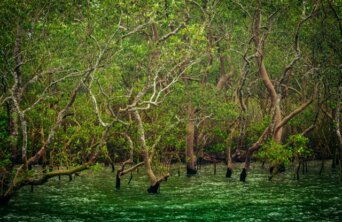- About
- Topics
- Picks
- Audio
- Story
- In-Depth
- Opinion
- News
- Donate
- Signup for our newsletterOur Editors' Best Picks.Send
Read, Debate: Engage.
| topic: | Conservation |
|---|---|
| located: | India |
| editor: | Bindu Gopal Rao |
Mangroves are known to combat the effects of sea-level rise, coastal flooding, and storms, but what sets them apart is their high carbon sequestration capacity and ability to host fish, crabs, and other shellfish.
India hosts 3.5% of the world’s mangroves. It is home to Sundarbans in West Bengal, a UNESCO World Heritage Site with the most extensive mangroves in the country, and the only mangroves to be the home of the Royal Bengal tigers.
India joined the Mangrove Alliance for Climate (MAC) during COP27 to spread awareness of the role of mangroves in dealing with climate change. The annual Union Budget 2023-24 has made specific allocations for green growth, including augmenting mangrove vegetation.
The government has also launched initiatives like the green credit programme, Mangrove Initiative for Shoreline, Habitat and Tangible Incomes, and the MISHTI Scheme for the coastline.
Several areas also use mangroves for tourism by promoting activities like kayaking and boating, which have boosted local economies. Studies have indicated that mangroves offer numerous advantages, including storing 200 million tonnes of carbon for every one per cent of their cover.
While their cover in India has grown, the areas in which mangroves grow are threatened. One of the biggest threats comes from the commercialisation of coastal regions for aquaculture, coastal development, farming and industrial activities.
Experts suggest innovative restoration techniques to revive declining mangroves. A decline in mangrove cover has negative implications for coastal communities and the surrounding flora and fauna. As a resilient ecosystem, mangroves require additional conservation efforts to serve as guardians of the coast.
Some state governments like Maharashtra, Goa, Andamans, Nicobar Islands, and Odisha have designated specific mangrove areas as ‘protected forests’ or ‘national parks and sanctuaries’. These measures also help in ensuring that these fragile ecosystems are conserved.
When all key stakeholders come together, practical implementation of laws and regulations can protect fragile ecosystems.
Image by Maitheli Maitra.

